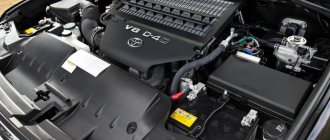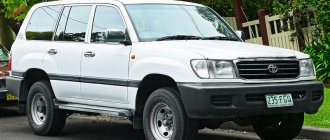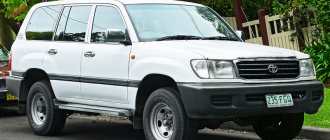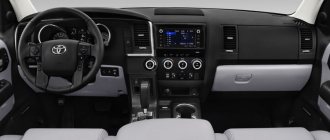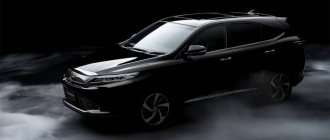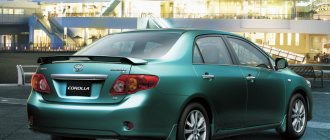The Toyota FJ Cruiser SUV is a good quality reincarnation of its ancestor FJ40 from the 60s and 70s. The last FJ40 was released in 1981, and it took the company another twenty years to recreate this model. Work on it began in earnest in the early 2000s, and in 2003 the concept was ready, which literally captivated the audience at the North American International Auto Show.
Toyota's top brass had their own ideas for this show. The FJ Cruiser was a kind of advertising campaign, a subtle marketing ploy that was supposed to attract the public's attention and fuel interest in the SUV niche as a whole. And they succeeded! The car turned out to be bright, expressive, unusual, in a word. Two years later, the Toyota FJ Cruiser was already on the assembly line and was in demand.
FJ Cruiser from the inside
The FJ Cruiser was placed on the Prado platform, which provided the necessary “off-road” foundation for the future car. Its dimensions do not look titanic and correspond to the average ones:
- length – 4.67 m;
- width – 1.89 – 1.90 m;
- height – 1.82 m;
- ground clearance – 24 cm;
The weight of the standard configuration was 1.9 tons. The power unit was a four-liter gasoline V6 with a capacity of 239 horses. This was enough to accelerate the Toyota fj Cruiser from zero to hundreds in 8.4 seconds with a maximum of 180 km/h. Claimed consumption was 13 liters in the city and 11 on open roads. But as practice has shown, after a hundred kilometers per hour, consumption increased sharply and reached a level of 15-17 liters per hundred (more on the shortcomings later). With a tank volume of 72 liters, you can travel long distances. In the tenth year, the engine was improved and there were 21 more horses, but this only increased consumption in city driving mode, leaving other speed characteristics at the same level.
It will also be interesting to read: Pajero 4 or Prado 150, which is better today?
Two types of transmission were installed on the FJ:
- 6-speed manual;
- 5-speed automatic.
The SUV was equipped with rear-wheel drive with the ability to connect to Part Time all-wheel drive and downshift. And there are disc brakes on each wheel. The brakes are perforated on the rear axle for ventilation.
Toyota FJ Cruiser (2006-present)
What can you expect from used copies? A deliberately angular body with round eyes of the front optics and a silver edging of the radiator grille, which, instead of the corporate emblem, is crowned with the Toyota inscription, and is framed on the sides by orange turn signals - in these features of the FJ Cruiser's retrospective appearance, connoisseurs and admirers of the Japanese brand will easily recognize the image of the legendary FJ40 model, in in the early 60s, which formed a positive image in the automotive world of all-terrain and rugged Toyota off-road vehicles. The rough appearance of the hero of our material is intended to emphasize that this car is not afraid of even serious obstacles on the way.
The FJ Cruiser is built on the Toyota Prado platform - the main components and assemblies were borrowed from it. Initially, the car was aimed at the American market, but later it was also offered for eastern countries. The FJ Cruiser was not officially sold here; all the cars available in Ukraine came to us through “gray” dealers. The majority are “Americans”; “Arabs” are less common. Externally, the FJ Cruiser from the States can be distinguished by the presence of a roof rack and small daytime running lights in the side mirrors, and internally by the instrument panel, digitized in miles, and the absence of a dead zone sector in the left exterior mirror. The car was offered in two versions - the more expensive one can be easily identified by the presence of additional instruments at the top of the dashboard and an audio system with a 6-disc CD changer and a standard subwoofer in the trunk. Cheap versions should be criticized for poor sound insulation. But the interior equipment of all FJ Cruisers is Japanese-style, reliable and problem-free.
When creating the FJ Cruiser, the designers were inspired by the Toyota FJ40 SUV (1960–1984). From it there is a branded radiator grille with round headlights and orange turn signals on the sides, branded blue and yellow body colors.
The interior is decorated in the spartan style of the legendary FJ40. The plastic of the panels is hard, but not creaky. Visibility is poor, and the sound insulation of simpler versions is rather weak. The rear axle of expensive versions is locked forcibly. Despite its coupe-like appearance, the FJ Cruiser is a 5-door SUV, its camouflaged rear doors swing back against the direction of travel. According to mechanics, this design feature did not negatively affect reliability - the door mechanisms work properly throughout the entire life of the car. Unless the absence of central pillars provokes the appearance of unnecessary noise over time (see “Weak points”). It’s not for nothing that we applied the word “coupe-like” to this model - in addition to the external similarity, there is a similarity in the spaciousness of the interior: there is little legroom for passengers in the rear seat.
A special feature of the FJ Cruiser is that the short rear doors open against the direction of travel, and this can only be done by first opening the front doors. There is not much legroom in the gallery, but it is enough for passengers of average height. The FJ Cruiser has a tank-like visibility that takes some getting used to. It is limited by a narrow windshield and an overhanging roof (which makes it difficult to read tall traffic lights), a wide C-pillar, a high line of side windows and a spare wheel mounted on the trunk door. The convenience of using the trunk is enhanced by the glass opening separately from the door - you can throw light luggage through it.
The FJ Cruiser's trunk volume of 790/1890 liters is average compared to competitors - for example, 835/1575 liters for the Hummer H3 and 1310/2320 liters for the 5-door Jeep Wrangler. Convenience is facilitated by a flat cargo area, which is obtained by folding the rear seats.
The FJ Cruiser is offered with the only power unit borrowed from the related Prado – a 4.0 liter V6 petrol. In principle, there is no choice and options for transmissions - the lion's share of cars on the Ukrainian market are equipped with an automatic transmission with forced all-wheel drive. Versions with “mechanics” and permanent all-wheel drive are rare.
Visibility of the FJ Cruiser is limited by the spare tire mounted on the trunk door, the wide C-pillar, the high line of the side windows, the narrow windshield and the roof hanging over it. Buyers can only be pleased that the FJ Cruiser, which is operated as rear-wheel drive in normal modes, is more economical than 4.0-liter Prados equipped with permanent all-wheel drive - it can consume 14-15 liters per “hundred” versus 17-18 liters, respectively. By the way, in 2010, the FJ Cruiser engine became more powerful by 22 “horses”, already delivering 264 hp. With.
An important advantage of FJ Cruiser units is high reliability. According to domestic operating experience, no characteristic weaknesses were identified in them. Unless during active off-road use with overcoming deep fords, the tension roller of the attachment belt does not last long (this will be indicated by a characteristic whistle when the engine is running). And with “civilian” driving, it is capable of reaching about 200 thousand km. The belt can withstand about 100 thousand km.
In addition, motorists drew attention to the need for regular (every 20–30 thousand km) cleaning of the “injectors”. Contamination of the fuel injectors is manifested by unstable operation at idle. Power units are not particularly demanding in terms of maintenance - their timing belt uses a durable metal chain.
Off-road, just like at home! We have already mentioned that most FJ Cruisers are equipped with all-wheel drive; the front axle is activated by the transfer case lever using a clutch servo drive. Expensive versions are equipped with a rear axle lock, while in simpler ones it is imitated by the electronics of the ESP system, which brakes the slipping wheels (one or more of the 4). FJ Cruiser owners value it very much for its high off-road qualities - the cross-country ability of this model is simply impressive!
The FJ Cruiser, like its legendary progenitor, is distinguished by high cross-country ability - this is facilitated by a reduction gear and inter-wheel diff locks, a ground clearance of 220 mm and short body overhangs. In general, the transmission has proven itself to be reliable, except that during careless off-road driving, frequent cases of breakage of the electrical wiring of the front axle coupling were noted. By the way, all-wheel drive may not work due to a breakdown of the system for suctioning gasoline vapors from the tank.
The automatic gearbox also proved to be durable in off-road tests. True, for long-term and trouble-free operation, you must not forget to service the transmission every 40 thousand km - change the lubricant in the gearbox, transfer case and rear axle.
The chassis of the FJ Cruiser is similar to the related Prado: an independent double-wishbone suspension is used at the front, and a powerful solid axle at the rear. However, it is configured differently - unlike the Prado, which, when actively cornering and sharp braking, rolls unpleasantly and nods, the FJ Cruiser is more stable, although its suspension is also energy-intensive.
The rear axle is a reliable and strong unit; the “rubber bands” of its mounting rods have not yet had to be changed.
The weak point of the front end is the wheel bearings. The right one lasts the least - 60-70 thousand km, and the left one can last about 100 thousand km. An important condition when replacing them is the obligatory renewal of the seals of the external “grenades” - otherwise the new bearing will not come out for a long time. Often (every 60–70 thousand km) the stabilizer bushings are also changed. At the same time, ball joints can last about 150 thousand km, and silent blocks of levers, as a rule, have to be changed due to souring of the adjusting eccentrics in them and the impossibility of adjusting the camber of the front wheels. To avoid problems with each such adjustment, it is recommended to lubricate the eccentrics.
The steering is equipped with variable power steering. The weak point is the steering rods, which on our roads have to be changed on average every 60–70 thousand km. At the same time, the FJ Cruiser unit does not have the “illness” characteristic of the Prado, in which the steering shaft driveshaft often begins to knock at 80–100 thousand km.
Since the powerful power unit allows you to drive quite actively, those who like to drive fast often get deformed front brake discs. In addition, to avoid problems with the parking brake, which is driven by a separate drum mechanism, mechanics advise cleaning and lubricating it every 40 thousand kilometers.
Weak spots
Over time, the body of the FJ Cruiser cracks in the area of the outermost front frame supports. This is typical for cars before 2010 that drive off-road or with heavy brakes.
Due to salty winter roads, the paintwork on branded alloy wheels becomes unusable (peels off).
Due to the lack of central pillars of the body, over time the doors on the seals begin to creak. They solve the problem by impregnating rubber products with silicone lubricants.
The gasoline vapor absorber of cars before 2009 fails if the owner fills fuel under the neck. Its refusal is accompanied by the alarming check engine sign.
Interior – exterior
From its predecessor, the Toyota FJ Cruiser received round headlights and a retro grille. The door design exceeded any expectations. It turned out to be two doors and a half door, swinging open in different directions, providing full access to the interior. The windshield turned out to be so wide that it was advisable to install three windshield wipers. Massive rear-view mirrors were supposed to provide a good overview. With his entire appearance, he declares his aggressiveness and the nature of an SUV. Considered one of the best SUVs.
The interior is made simply, technologically and as practical as possible. Special hydrophobic materials were used that can be easily washed with water. Ergonomics turned out to be at the level, and the dashboard is not oversaturated with sensors and dials. Only the driver and front passenger will be able to sit comfortably. And three seats in the back is only documented. One could sacrifice trunk space, which has a capacity of 790 liters.
Toyota FJ Cruiser. Reviews about the SUV
I bought a used car. The previous owner made some nice improvements to the Toyota FJ Cruiser. Fuel consumption was slightly reduced. In addition, based on the condition of the vehicle, it was used quite rarely for its intended purpose. That is, there was virtually no real off-road driving. The purchased car was in perfect condition - the body is without scratches, everything in the interior is very clean, the luggage compartment is like new. At first there were no problems, but when the euphoria from the acquisition wore off, the first flaws began to appear. So, the chassis was a little upset. One winter, even the shock absorbers froze. The reason turned out to be the rigid tuning of the front suspension. But in general, exclusively positive emotions from owning the model prevail. I really like the vehicle’s cross-country ability and the reliable operation of the power plant.
Gennady R. Ownership period for Toyota FJCruiser 4.0 MT is 3 years.
The idea of changing the car arose spontaneously. Before that, I drove an Outlander quite safely and everything suited me there. But a couple of times I had quite a hard time driving off-road, so I decided to try to switch to a more passable model. I accidentally came across a Toyota FJ Cruiser and after a preliminary inspection I became seriously interested. I really liked the appearance of the car. After consulting with friends and family, I finally decided to purchase. The car is very obedient on the road. It goes where it needs to go without any problems. I am pleased with the high-quality visibility and very large side mirrors (like a bus). It’s a little unusual to climb inside - the seating position is too high. Otherwise, everything is fine.
Igor R. Ownership period for Toyota FJCruiser 4.0 MT is 1 year.
The car is very unusual. I've owned SUVs before, but after this model they all seem like cars. From the outside the car is very attractive. It is also beautiful and spacious inside. The engine is quite powerful. There are enough horses not only to overcome off-road conditions, but also to demonstrate speed on a straight track. The seats are very large and comfortable - everything you need for a comfortable trip. On the negative side, it should be noted that there is feedback in the steering wheel when driving over uneven surfaces. It should also be noted that it will be quite difficult to get to the rear lights if necessary. The hand does not fit into the opening for changing dimensions. And the trunk was a little discouraging. Yes, it is quite large, but there are no compartments or organizers for convenient storage of various small items.
Anton K. Ownership period for Toyota FJCruiser 4.0 MT is 2 years.
Price
The Toyota FJ Cruiser was not officially presented by car dealers, so the price for a new copy will be purely conditional. In the States, the latest model would cost around 23 thousand dollars. By adding transport costs and customs clearance to this amount, we get the cost in our market. A used copy can be purchased for 1.2 million rubles on any website. For this money we get a good cross-country SUV that will go uphill and ford a river (if it is not deeper than 70 cm).
But not everything worked out comfortably. Many drivers note poor sound insulation, the stiffness of the suspension does not allow you to relax and quickly tires you, and fuel consumption is ready to take a significant share of the budget. This is also influenced by the shape of the car, which is not ready to boast of being streamlined. The size of the side mirrors does not indicate practicality; visibility leaves much to be desired.
It will also be interesting to read: SUVs 2017-2018 model year, new products from the domestic and foreign auto industry
The result is a good, original SUV with high fuel consumption, but little adapted to city driving. Next is a video review about the Toyota FJ Cruiser:
Rate this article
